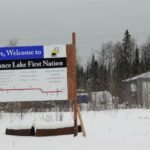Alberta Premier Danielle Smith is eager to show that her government can finally put the pieces of a dismantled provincial health-care system back together in the new year.
In a recent year-end interview, Smith said the work he began in 2023 to create four new organizations in place of one health authority is almost complete, but there is still more to do.
“I think next year will be the true test of the new model,” he said.
Critics have said the restructuring would separate decision-making into silos, make the system harder for patients and workers to navigate, add layers of bureaucracy and fail to address shortages of health care workers and hospital beds.
Some of the most important pieces to come together include making sure everyone has access to a family doctor and reducing surgical wait times to doctor-recommended timelines.
For Smith, it has been about identifying big problems and starting to solve them.
“That, for me, has been really rewarding,” he said, pointing to the introduction of a new salary model for nurse practitioners, the expansion of the role of pharmacists and the increase in the number of surgeries in private facilities.
Smith’s United Conservative Party government stayed busy on other fronts in 2024.
Smith highlighted “great progress” in tightening electricity market rules to try to calm volatile prices and reduce energy bills, including by introducing a new default rate from January.
He also said Alberta has had to deal with more than 1,200 wildfires, including one that devastated the mountain town of Jasper in July.
In the spring, the Smith government laid the groundwork for a new provincial police service and has committed an increasing amount of money to sheriff-led projects, including beefing up security on Alberta’s southern border with Montana.
The UCP also moved forward with new regulatory obstacles to the development of renewable solar and wind energy.
And a provincial law displayed partisan banners at the local level. In the upcoming municipal elections in October, municipalities will be forced to count votes manually, among other changes that will reshape the political landscape.
Smith has the unwavering support of the UCP. He earned a resounding 91.5 per cent approval rating among party members in November, shortly after introducing a new Alberta Bill of Rights, which promises to protect the right to refuse vaccines.
She remains buoyed by her near-constant legal and symbolic pushback against the federal Liberal government, always unpopular in Alberta, and her willingness to turn socially conservative proposals into government policy.
In that sense, the government also passed legislation that restricts medical care for transgender people and which now faces a court challenge.
The cost of Smith’s health care restructuring, estimated by the government at $85 million, won’t be the only line item that will reduce Alberta’s budget in the new year.
Billions of dollars have been pledged over the next three years to build new schools, while classrooms are bursting at the seams.
Some 250,000 public sector workers are still in collective bargaining talks with government employers.
All this as Finance Minister Nate Horner warns of the “real risk” of a deficit on the horizon, depending on whether the oil price falls below budget projections.
The government’s forecasts do not take into account the effect of future policies, including the 25 percent tariffs threatened by incoming US President Donald Trump.
As the Alberta government prepares its 2025 budget, a billion-dollar regret lingers in Smith’s mind.
“We probably should have included the tax cut in our first budget,” Smith said.
That key election promise to save taxpayers hundreds of dollars a year starting in 2023-24 may be fulfilled four years later.
“We heard that was something that was disappointing to the people who supported us,” Smith said.
“It might have been better for Albertans if we had implemented it and then found a way to be able to pay for it.”
When she and Horner postponed it, there was uncertainty with oil and gas prices, the Trans Mountain pipeline expansion project and population growth.
“We postponed it, but we heard loud and clear that people needed that tax relief,” he said.
With the province’s population growing, income tax revenue has also slowly increased, from $15.1 billion in 2023-24 to a projected $16.5 billion in 2024-25.
Smith said the year-over-year increase was a surprise.
He also pointed to Saskatchewan Premier Scott Moe, who has taken steps to implement a personal tax cut promised in the recent election campaign that gave his Saskatchewan Party another majority government.
“Scott Moe learned the lesson I learned and campaigned for a tax cut,” Smith said.
When asked at what point his unfulfilled promise becomes a broken promise, Smith said he is pleased to see many long-term revenue sources increasing and that tax cuts are still on his agenda.
“That is giving the Finance Minister some comfort. I have asked him to look at ways to accelerate, so by the end of February we will know if he has been able to do that.”
This report by The Canadian Press was first published Dec. 25, 2024.








